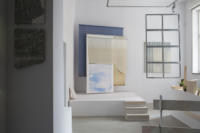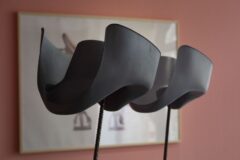„Stan surowy otwarty” w Gdańskiej Galerii Miejskiej / „Pre-Lock-Up Stage” at Gdańska Galeria Miejska

Między nami znów zaiskrzy,
Odnajdziemy blask i wdzięk,
Zakończymy smutny shopping
Sztucznych, galeryjnych szczęść.
I będzie jak dawniej,
Przestańmy się spieszyć,
Zacznijmy od nowa,
Od tych małych rzeczy.
Sylwia Grzeszczak, Małe rzeczy (2011)
Jesienią 1985 roku w Moderna Museet w Sztokholmie miała miejsce wystawa Dialog. Brało w niej udział ośmiu polskich artystów związanych ze środowiskiem galerii Foksal. Ponieważ formuła pokazu opierała się na tytułowym dialogu, każdemu z nich dano możliwość zaproszenia jednego dowolnego artysty z zagranicy. W projekcie wzięli udział: Henryk Stażewski – Daniel Buren, Edward Krasiński – Lars Englund, Maria Stangret – Christian Boltanski, Zbigniew Gostomski – Barry Flanagan, Lesław i Wacław Janiccy – Gilbert & George, Tomasz Tatarczyk – Susan Rothenberg, Leon Tarasewicz – Ian McKeeyer. Faktem jest, że zaproszeni do udziału w wystawie artyści nigdy się nie spotkali. Forma dialogu stała się więc jedynie jego zapowiedzią i impresją, a wystawa kolażem myśli i treści oraz rodzajem symulacji poznania. Z drugiej strony przybrała rolę kreatora myśli dialektycznej, rezonującej, poprzez wielokierunkowe poszukiwania, stawiając na piedestale doświadczenie. Dialog postawił pytanie o formę i sens kreacji tego typu działań.












Z końcem września 2013 roku na antenie telewizji Polsat zostaje wyemitowany pierwszy odcinek programu Nasz nowy dom. Jest to program oparty na niezawodnych produkcjach tego rodzaju z USA. Rodziny, które zostały wybrane do udziału, mieszkają w fatalnych warunkach, a ich status ekonomiczny jest bardzo niski. Pod czujnym okiem kamer specjaliści przerzucają się pomysłami, tocząc wyścig z czasem i przeciwnościami losu. Ekipa programu z Katarzyną Dowbor na czele dokonuje, wydawałoby się niemożliwego, w pięć dni remontuje dom wybranej rodziny, dając jej tym samym namiastkę luksusu i stabilizacji. Domownicy stają się aktorami, którzy 'po ostatnim klapsie’ anonsującym zakończenie nagrania, pozostają osamotnieni w swojej 'nowej rzeczywistości’. Ogrzani światłem kamer i blaskiem celebrytów mają rozpocząć lepsze życie w poczuciu własnej wyjątkowości.
Te dwie historie są swego rodzaju paralelą dla działań, jakie podjęli artyści oraz kuratorzy formułujący wystawę Stan surowy otwarty. Jest to druga ekspozycja w ramach projektu Północ – Południe, który ma na celu konfrontować twórców z dwóch krańców Polski. Tak więc pytanie o dialog staje się w tym miejscu jak najbardziej zasadne.
Przywołana figura programu telewizyjnego z Katarzyną Dowbor przypomina działania, jakie wzięli na siebie twórcy projektu. W równe pięć dni ekipa techniczna pod kierownictwem Gabrieli Warzyckiej-Tutak oraz Aleksandra Celusty przystąpiła do montażu wystawy. Wnętrze galerii, pozbawione tradycyjnej funkcji wystawienniczej, zostaje tutaj sprowadzone przede wszystkich do roli i rangi malarskiej, podłoża, na którym ściana staje się nośnikiem treści. Narracja wystawy budowana jest w ciągłej relacji z zaproszonymi do wystawy twórcami. Etap montażu staje się doświadczeniem, próbą unifikacji architektury, rzeźby oraz malarstwa zacierając granicę pomiędzy sztuką a życiem. Etap ten dąży do wykreowania wspólnego „świata” dla twórcy i odbiorcy.












There’ll be a new spark between us,
We’ll find brilliance and charm,
We’ll finish the sad shopping,
Of artificial mall happiness,
And it’ll be like it used to be,
Let us stop rushing,
Let us start all over again,
From these small things.
Sylwia Grzeszczak, Small Things (2011)
In the autumn of 1985, Moderna Museet in Stockholm hosted the exhibition Dialogue. The participants included eight Polish artists affiliated with the milieu of the Foksal Gallery. Since the formula of the show was based on the eponymous dialogue, each of the artists was given a chance to invite another artist from abroad. Thus, the show featured: Henryk Stażewski – Daniel Buren, Edward Krasiński – Lars Englund, Maria Stangret – Christian Boltanski, Zbigniew Gostomski – Barry Flanagan, Lesław and Wacław Janicki – Gilbert & George, Tomasz Tatarczyk – Susan Rothenberg, Leon Tarasewicz – Ian McKeeyer. As a matter of fact, the artists invited to participate in the exhibition never met. Therefore, the form of the dialogue became merely a harbinger and an impression, and the exhibition itself – a collage of thoughts and content as well as a kind of simulation of getting to know each other. On the other hand, it adopted the role of the creator of dialectical thought, which resonates through multidimensional investigations, granting prominence to experience. Dialogue posed a question about the form and sense of creating this type of activities.












In the end of September 2013, the TV station Polsat broadcasts the first episode of the show Our New House. It is based on the trusted American productions of the same sort. The families selected to participate live in dreadful conditions, and their financial status is very low. Under the vigilant eye of the camera, specialists exchange ideas, racing against the clock and adversities. The crew of the show, headed by Katarzyna Dowbor, achieves what appears to be an impossible goal and renovates the house of a selected family within five days, thus giving its members an ersatz of luxury and stability. The family members become actors who are left alone in their “new reality” after “the last clap” that announces the end of shooting. Illuminated by the glow of the cameras and celebrities, they are supposed to start a better life with a sense of their own uniqueness.
These two stories provide a kind of parallel for the activities undertaken by the artists and curators of the exhibition Pre-Lock-Up Stage. It is the second exhibition within the project North – South, whose goal consists in confronting artists from two opposite ends of Poland. Thus, the question of dialogue indeed becomes relevant.
The evoked television show with Katarzyna Dowbor resembles the activity undertaken by the creators of the project. Having exactly five days to go, the technical crew headed by Gabriela Warzycka-Tutak and Aleksander Celusta embarked on installing the show. Deprived of its traditional exhibition function, the gallery interior is reduced here primarily to the painterly role and rank, it becomes a base on which the wall becomes the carrier of content. The narrative of the exhibition develops in a constant relation with the invited artists. The installation stage becomes an experience, an attempt to unify architecture, sculpture and painting, thus blurring the border between art and life. The aim of this stage is to create a common “world” of the artist and the viewer.
Przypisy
Stopka
- Osoby artystyczne
- Daniel Cybulski, Radosław Deruba, Emilia Kina, Filip Rybkowski, Robert Seikon, Michał Sroka
- Wystawa
- Stan surowy otwarty / Pre-Lock-Up Stage
- Miejsce
- Gdańska Galeria Miejska 1
- Czas trwania
- 28.04 - 09.07.2017
- Osoba kuratorska
- Gabriela Warzycka-Tutak, Aleksander Celusta
- Strona internetowa
- ggm.gda.pl









